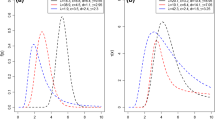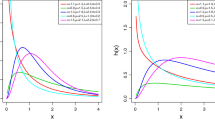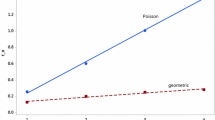Abstract
The concept of the identifiability of mixtures of distributions is discussed and a sufficient condition for the identifiability of the mixture of a large class of discrete distributions, namely that of the power-series distributions, is given. Specifically, by using probabilistic arguments, an elementary and shorter proof of the Lüxmann-Ellinghaus's (1987,Statist. Probab. Lett.,5, 375–378) result is obtained. Moreover, it is shown that this result is a special case of a stronger result connected with the Stieltjes moment problem. Some recent observations due to Singh and Vasudeva (1984,J. Indian Statist. Assoc.,22, 93–96) and Johnson and Kotz (1989,Ann. Inst. Statist. Math.,41, 13–17) concerning characterizations based on conditional distributions are also revealed as special cases of this latter result. Exploiting the notion of the identifiability of power-series mixtures, characterizations based on regression functions (posterior expectations) are obtained. Finally, multivariate generalizations of the preceding results have also been addressed.
Similar content being viewed by others
References
Akhiezer, N. I. (1965).The Classical Moment Problem, Oliver & Boyd, Edinburgh.
Barndörff-Nielsen, O. (1965). Identifiability of mixtures of exponential families,J. Math. Anal. Appl.,12, 115–121.
Cacoullos, T. (1987). Characterizing priors by posterior expectations in multiparameter exponential family,Ann. Inst. Statist. Math.,39, 399–405.
Diaconis, P. and Ylvisaker, D. (1979). Conjugate priors for exponential families,Ann. Statist.,7, 269–281.
Ericson, W. A. (1969). A note on the posterior mean of a population mean,J. Roy. Statist. Soc. Ser. B,31, 332–334.
Feller, W. (1968).An Introduction to Probability Theory and its Applications, Vol. 1, 3rd ed., Wiley, New York.
Fraser, M. D., Hsu, Yu-Sheng and Walker, J. J. (1981). Identifiabilities of finite mixtures of Von-Mises distribution,Ann. Statist.,9, 1130–1134.
Johnson, N. L. (1957). Uniqueness of a result in the theory of accident proneness,Biometrika,44, 530–531.
Johnson, N. L. (1967). Note on a uniqueness of a result in certain accident proneness model,J. Amer. Statist. Assoc.,62, 288–289.
Johnson, N. L. and Kotz, S. (1989). Characterization based on conditional distributions,Ann. Inst. Statist. Math.,41, 13–17.
Kent, J. T. (1983). Identifiability of finite mixtures for directional data,Ann. Statist.,11, 984–988.
Lüxmann-Ellinghaus, U. (1987). On the identifiability of mixtures of infinitely divisible power-series distributions,Statist. Probab. Lett.,5, 375–378.
Mossiman, J. E. (1963). On the compound negative multinomial distribution and correlations among inversely sampled pollen counts,Biometrika,50, 47–54.
Patil, G. P. (1965). Certain characteristic properties of multivariate discrete probability distributions akin to the Bates-Neyman model in the theory of accident proneness,Sankhyā Ser. A,27, 259–270.
Patil, G. P. and Bildikar (Talwalker), S. (1966). Identifiability of countable mixtures of discrete probability distributions using methods of infinite matrices,Proc. Camb. Phil. Soc.,62, 485–494.
Prakasa Rao, B. L. S. (1992).Identifiability in Stochastic Models: Characterization of Probability Distributions, Academic Press, London.
Sankaran, M. (1970). The discrete Poisson-Lindley distribution,Biometrics,26, 145–149.
Shohat, J. A. and Tamarkin, J. D. (1963).The Problem of Moments, 2nd ed., American Mathematical Society, New York.
Sibuya, M. (1979). Generalized hypergeometric, digamma and trigamma distributions,Ann. Inst. Statist. Math.,31, 373–390.
Singh, H. and Vasudeva, H. L. (1984). A characterization of exponential distribution by Yule distribution,J. Indian Statist. Assoc.,22, 93–96.
Tallis, G. M. (1969). The identifiability of mixtures of distributions,J. Appl. Probab.,6, 389–398.
Tallis, G. M. and Chesson, P. (1982). Identifiability of mixtures,J. Austral. Math. Soc. Ser. A,32, 339–348.
Teicher, H. (1960). On the mixture of distributions,Ann. Math. Statist.,31, 55–73.
Teicher, H. (1961). Identifiability of mixtures,Ann. Math. Statist.,32, 244–248.
Teicher, H. (1963). Identifiability of finite mixtures,Ann. Math. Statist.,34, 1265–1269.
Titterington, D. M., Smith, A. F. M. and Makov, U. E. (1985).Statistical Analysis of Finite Mixtures Distributions, Wiley, New York.
Yakowitz, S. J. and Spragins, J. D. (1968). On the identifiability of finite mixtures,Ann. Math. Statist.,39, 209–214.
Author information
Authors and Affiliations
About this article
Cite this article
Sapatinas, T. Identifiability of mixtures of power-series distributions and related characterizations. Ann Inst Stat Math 47, 447–459 (1995). https://doi.org/10.1007/BF00773394
Received:
Revised:
Issue Date:
DOI: https://doi.org/10.1007/BF00773394




